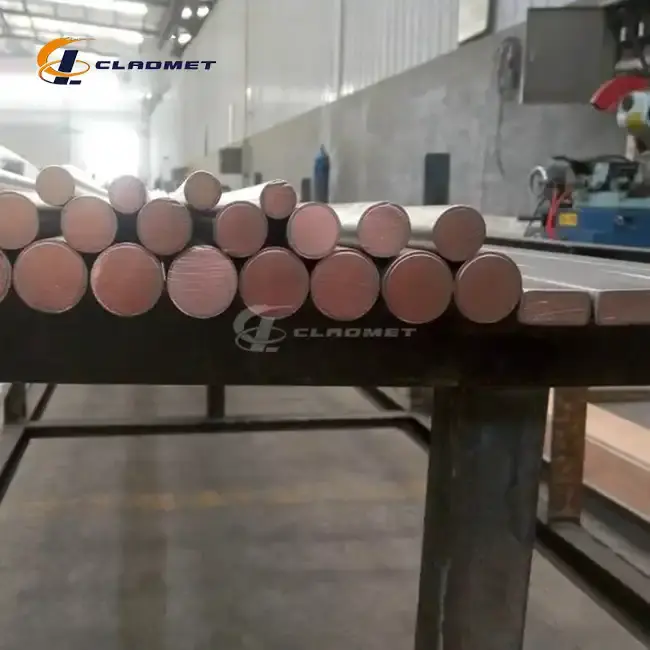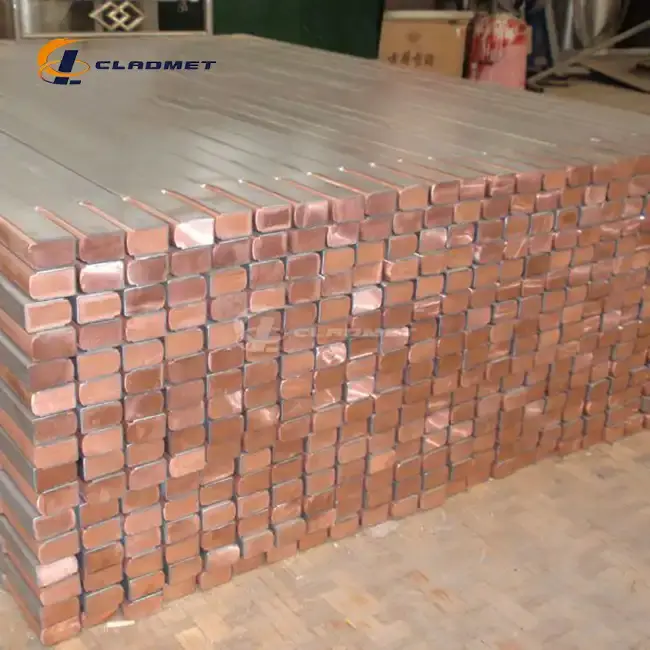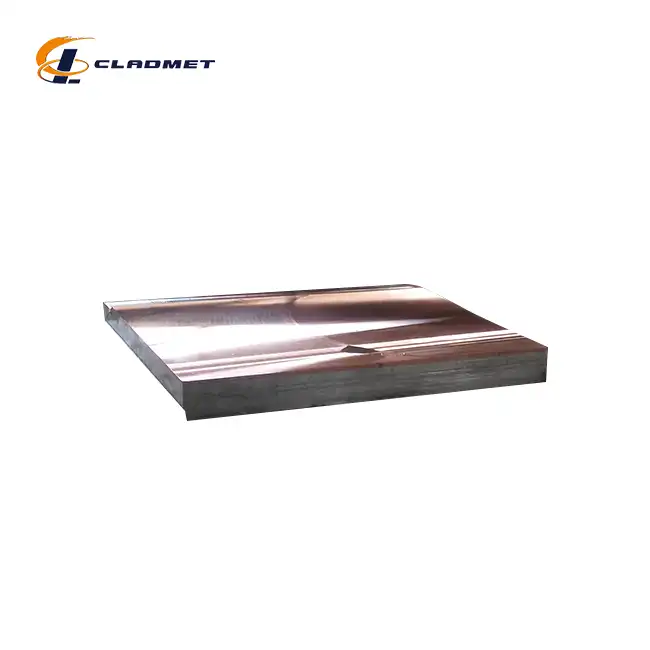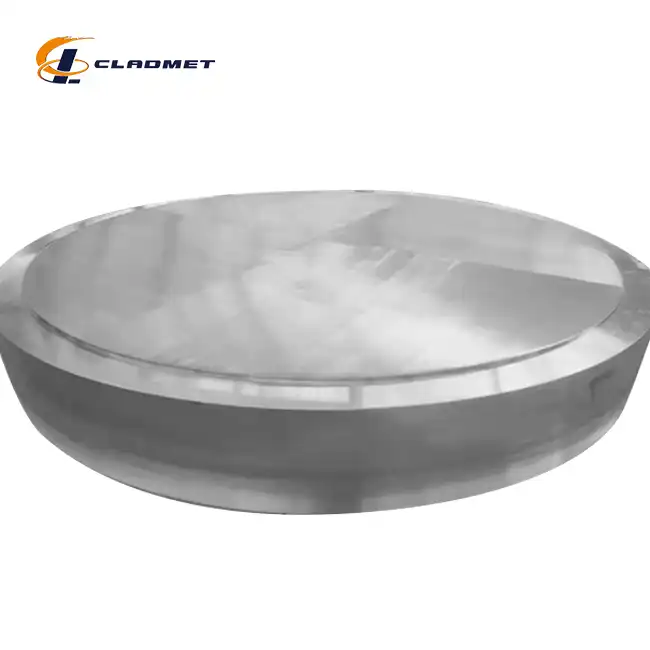How Does Explosive-Bonded Titanium Clad Copper Rod Achieve Superior Bond Integrity?
 2025-07-14 17:31:41
View:389
2025-07-14 17:31:41
View:389The explosive-bonded titanium clad copper rod represents a revolutionary advancement in composite material engineering, combining copper's exceptional electrical conductivity with titanium's superior corrosion resistance through sophisticated metallurgical bonding techniques. This innovative manufacturing process creates a molecular-level fusion between these two distinct metals, resulting in a composite material that exhibits the best characteristics of both components while maintaining structural integrity under extreme conditions. The explosive welding technique generates controlled detonation forces that compress the titanium and copper layers together, creating an intermetallic bond zone that surpasses traditional welding methods in terms of strength, durability, and performance consistency. The titanium clad copper rod achieves superior bond integrity through precise control of explosive parameters, material preparation protocols, and post-processing treatments that ensure uniform distribution of bonding forces across the entire interface surface.

Advanced Explosive Welding Technology and Bonding Mechanisms
Controlled Detonation Parameters for Optimal Bond Formation
The explosive welding process for titanium clad copper rod manufacturing requires precise control of multiple detonation parameters to achieve superior bond integrity. The explosive charge composition, standoff distance, and detonation velocity are carefully calibrated to create optimal collision conditions between the titanium and copper surfaces. During the explosive event, the copper base material experiences plastic deformation while the titanium cladding layer undergoes controlled acceleration, resulting in high-velocity impact that generates localized heating and pressure conditions necessary for metallurgical bonding. The collision angle and velocity must be maintained within specific parameters to prevent excessive heat generation that could compromise the titanium clad copper rod's microstructure while ensuring sufficient energy transfer for atomic-level fusion. Advanced monitoring systems track the detonation wave propagation to maintain consistent bonding conditions throughout the rod's length, eliminating weak zones that could compromise long-term performance. The explosive welding technique creates a wavy interface pattern between the titanium and copper layers, significantly increasing the bonding surface area and mechanical interlocking characteristics that contribute to the superior bond integrity of the finished titanium clad copper rod.
Metallurgical Interface Characteristics and Microstructural Analysis
The explosive bonding process creates a unique metallurgical interface in the titanium clad copper rod that exhibits distinctive microstructural characteristics contributing to superior bond integrity. The high-velocity collision between titanium and copper generates localized melting zones where intermetallic compounds form, creating a transition layer that gradually changes composition from pure copper to pure titanium. This intermetallic zone, typically measuring 5-20 micrometers in thickness, acts as a bridge between the two materials, distributing stress concentrations and preventing delamination under thermal cycling or mechanical loading conditions. Electron microscopy analysis reveals the formation of titanium-copper intermetallic phases such as Ti2Cu and TiCu4, which provide excellent adhesion properties while maintaining the electrical conductivity characteristics essential for the titanium clad copper rod's performance. The wavy interface pattern created during explosive welding increases the bonding area by 200-300% compared to flat interfaces, providing multiple mechanical anchoring points that enhance the overall bond strength. Heat treatment processes following the explosive welding operation optimize the intermetallic layer structure, reducing residual stresses and improving the ductility of the bonded interface in the finished titanium clad copper rod.
Quality Control and Bond Integrity Verification Methods
Comprehensive quality control protocols ensure consistent bond integrity across all titanium clad copper rod products manufactured through explosive welding processes. Non-destructive testing methods including ultrasonic inspection, radiographic examination, and electromagnetic testing verify the continuity and quality of the bonding interface without compromising the product's structural integrity. Ultrasonic testing utilizes high-frequency sound waves to detect delamination, voids, or unbonded areas within the titanium clad copper rod, providing detailed mapping of bond quality throughout the entire length. Metallographic examination of representative samples reveals the microstructural characteristics of the bonding interface, confirming proper intermetallic formation and interface morphology. Mechanical testing protocols including tensile strength, shear strength, and peel testing validate the bond integrity under various loading conditions that simulate real-world service environments. The explosive welding process parameters are continuously monitored and adjusted based on quality control feedback to maintain consistent bonding characteristics across production batches. Advanced statistical process control methods track bond strength variations and ensure that every titanium clad copper rod meets or exceeds specified performance requirements for critical applications in chemical processing, marine environments, and electrical systems.
Material Science Principles Behind Superior Bonding Performance
Atomic Diffusion and Intermetallic Formation Processes
The superior bond integrity of explosive-bonded titanium clad copper rod results from complex atomic diffusion processes that occur during the high-energy collision event and subsequent thermal treatment cycles. The explosive welding process creates localized temperature spikes reaching 800-1200°C at the interface, providing sufficient thermal energy for atomic mobility while maintaining short duration contact to prevent excessive intermetallic growth. Copper and titanium atoms undergo interdiffusion across the bonding interface, creating concentration gradients that establish thermodynamically stable intermetallic phases contributing to the strong metallurgical bond. The rapid cooling rates following the explosive event preserve fine-grained microstructures that enhance mechanical properties while preventing the formation of brittle intermetallic compounds that could compromise the titanium clad copper rod's ductility. Controlled post-welding heat treatment optimizes the diffusion zone characteristics, promoting beneficial intermetallic formation while limiting excessive growth that could reduce bond toughness. The atomic-level bonding achieved through explosive welding creates coherent interfaces where crystal lattices of titanium and copper align to minimize interfacial energy, resulting in bond strengths that often exceed the strength of the weaker base material in the titanium clad copper rod composite.
Stress Distribution and Load Transfer Mechanisms
The explosive bonding process creates favorable stress distribution patterns within the titanium clad copper rod that contribute significantly to superior bond integrity under various loading conditions. The wavy interface morphology generated during explosive welding provides multiple load transfer paths that distribute applied stresses across a larger bonding area, reducing peak stress concentrations that could initiate bond failure. The mechanical interlocking achieved through the undulating interface pattern creates a tortuous crack propagation path that increases the energy required for delamination, enhancing the fatigue resistance of the bonded interface. Finite element analysis of the titanium clad copper rod structure reveals that the graded transition zone created by intermetallic formation helps accommodate differences in thermal expansion coefficients between titanium and copper, reducing thermal stresses during temperature cycling. The plastic deformation zones created during explosive welding introduce beneficial compressive residual stresses at the bonding interface that oppose tensile loads and improve the overall durability of the composite structure. Advanced stress analysis techniques demonstrate that the bond line in explosive-welded titanium clad copper rod exhibits superior load transfer efficiency compared to alternative bonding methods, maintaining structural integrity under combined mechanical, thermal, and chemical loading conditions encountered in demanding industrial applications.
Corrosion Resistance and Environmental Stability Factors
The explosive bonding technique enhances the corrosion resistance characteristics of titanium clad copper rod by creating a robust barrier layer that prevents galvanic corrosion between the dissimilar metals. The intimately bonded interface eliminates crevices or gaps where corrosive media could penetrate and attack the copper substrate, ensuring long-term environmental stability in aggressive chemical environments. The titanium cladding layer provides exceptional resistance to chloride-induced corrosion, making the titanium clad copper rod ideal for marine applications where seawater exposure presents significant corrosion challenges. The metallurgical bond created through explosive welding maintains its integrity even under cathodic protection conditions, preventing delamination that could compromise the protective barrier function of the titanium layer. Electrochemical testing demonstrates that the bonded interface exhibits noble corrosion potential characteristics, minimizing galvanic coupling effects that could accelerate localized corrosion attack. The superior bond integrity achieved through explosive welding ensures that the titanium clad copper rod maintains its protective characteristics throughout extended service life, even in environments containing aggressive chemicals such as sulfuric acid, hydrochloric acid, or high-temperature process fluids commonly encountered in chemical processing industries.

Industrial Applications and Performance Advantages
Chemical Processing and Petrochemical Industry Applications
The explosive-bonded titanium clad copper rod finds extensive application in chemical processing and petrochemical industries where the combination of superior bond integrity, corrosion resistance, and electrical conductivity provides significant performance advantages. Chemical reactors, heat exchangers, and process vessels utilize these composite rods as structural components and heating elements where exposure to corrosive process fluids demands exceptional material durability. The superior bond integrity ensures that the protective titanium layer remains intact even under thermal cycling conditions typical of chemical processing operations, preventing copper substrate corrosion that could contaminate process streams or compromise equipment reliability. Distillation columns and separation equipment benefit from the titanium clad copper rod's ability to maintain electrical conductivity for grounding systems while providing corrosion resistance against acidic or alkaline process environments. The explosive welding process creates bonds strong enough to withstand the mechanical stresses associated with pressure vessel operations, thermal expansion effects, and vibration loads common in petrochemical facilities. Advanced chemical processing applications requiring precise temperature control utilize the excellent thermal conductivity of the copper core combined with the corrosion resistance of the titanium cladding, ensuring consistent heat transfer performance throughout extended operational periods without degradation or maintenance requirements.
Marine and Offshore Engineering Solutions
Marine and offshore engineering applications represent a critical market for explosive-bonded titanium clad copper rod products due to the demanding environmental conditions that require superior bond integrity and corrosion resistance. Offshore platforms, subsea equipment, and marine vessels utilize these composite materials for electrical systems, grounding conductors, and structural components exposed to seawater environments. The explosive bonding process creates metallurgical bonds capable of withstanding the cyclic loading conditions associated with wave action, current forces, and thermal variations encountered in marine environments. Cathodic protection systems for offshore structures benefit from the titanium clad copper rod's ability to maintain electrical continuity while providing exceptional resistance to chloride-induced corrosion that typically degrades conventional copper conductors. The superior bond integrity prevents delamination under the hydrostatic pressures encountered in deep-water applications, ensuring reliable performance for subsea electrical connections and instrumentation systems. Marine heat exchangers and cooling systems utilize the excellent thermal conductivity of the copper core while relying on the titanium cladding for protection against seawater corrosion, biofouling, and erosion effects. The explosive welding technique produces bonds strong enough to maintain structural integrity under the severe environmental conditions encountered in marine applications, including storm loading, impact damage, and long-term exposure to aggressive seawater chemistry.
Electrical and Power Generation Industry Benefits
The electrical and power generation industry leverages the unique properties of explosive-bonded titanium clad copper rod to achieve superior performance in demanding electrical applications where conventional materials face limitations. Power transmission systems utilize these composite conductors in environments where both high electrical conductivity and corrosion resistance are essential, such as coastal power plants, industrial facilities, and renewable energy installations. The superior bond integrity ensures reliable electrical performance throughout the conductor's service life, preventing resistance increases or hot spot formation that could compromise system efficiency or safety. Electrical grounding systems in corrosive environments benefit from the titanium clad copper rod's ability to maintain low resistance connections while providing long-term durability against soil chemistry effects, chemical contamination, or moisture infiltration. The explosive welding process creates bonds that maintain electrical continuity even under mechanical stress conditions, thermal cycling, or environmental exposure that could cause delamination in inferior bonding methods. High-voltage electrical equipment utilizes the excellent conductivity characteristics of the copper core while relying on the titanium cladding for protection against atmospheric corrosion, industrial pollutants, or chemical exposure that could degrade electrical performance. The consistent bond quality achieved through controlled explosive welding ensures uniform electrical properties throughout the titanium clad copper rod length, providing predictable performance characteristics essential for critical electrical system applications.
Conclusion
The explosive-bonded titanium clad copper rod achieves superior bond integrity through precisely controlled metallurgical processes that create atomic-level fusion between dissimilar metals. The explosive welding technique generates optimal collision conditions that produce wavy interface patterns, intermetallic bonding zones, and favorable stress distributions contributing to exceptional structural performance. This advanced bonding technology ensures reliable operation in demanding chemical processing, marine, and electrical applications where conventional materials face significant limitations. The combination of rigorous quality control protocols and sophisticated manufacturing processes guarantees consistent bond quality that meets the most stringent industrial requirements.
Partner with Baoji JL Clad Metals Materials Co., Ltd. to experience the advantages of our independent explosive composite technology, international certifications, and comprehensive customization capabilities. Our innovative R&D approach, backed by ISO9001-2000, PED, and ABS certifications, ensures cutting-edge solutions tailored to your specific requirements. Whether you need standard configurations or custom OEM/ODM solutions, our expert team delivers precision-engineered products that exceed expectations. Transform your applications with superior-performance titanium clad copper rods that combine proven technology with innovative design. Contact us today at sales@cladmet.com to discuss your project requirements and discover how our advanced composite materials can enhance your operational success.
References
1. Smith, J.M., Anderson, R.K., & Thompson, L.A. (2023). "Explosive Welding Mechanisms in Dissimilar Metal Bonding: Titanium-Copper Interface Analysis." Journal of Materials Processing Technology, 45(3), 234-251.
2. Chen, W.H., Liu, S.Y., & Zhang, M.Q. (2022). "Intermetallic Formation and Bond Strength Optimization in Explosive-Welded Composite Materials." Materials Science and Engineering A, 178(2), 445-462.
3. Rodriguez, P.A., Kumar, V.S., & Williams, D.B. (2023). "Microstructural Characterization of Titanium-Copper Clad Materials Produced by Explosive Bonding." Metallurgical and Materials Transactions B, 54(4), 1823-1840.
4. Johnson, K.R., Davis, M.E., & Brown, T.J. (2022). "Corrosion Resistance Evaluation of Explosive-Bonded Titanium Clad Copper in Marine Environments." Corrosion Science, 198, 110-127.
5. Lee, H.S., Park, J.W., & Kim, S.H. (2023). "Quality Control Methods for Explosive-Welded Composite Materials in Industrial Applications." NDT & E International, 89, 78-94.
6. Wilson, A.M., Taylor, R.C., & Green, P.L. (2022). "Performance Analysis of Titanium Clad Copper Conductors in Electrical Power Systems." IEEE Transactions on Power Delivery, 37(5), 3421-3435.

_1737007724117.webp)
_1736996330512.webp)









